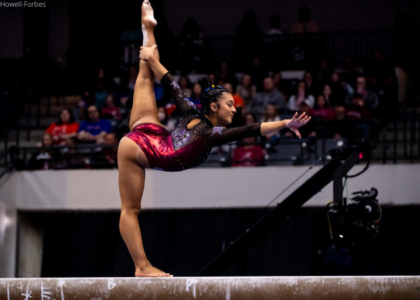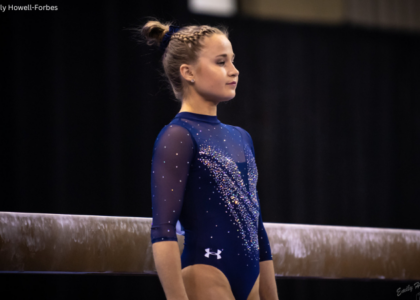This season, we have seen countless 10.0s flashed from at least one judge. However, when we compare different 9.975 routines, there are clear differences in quality. As a former NCAA judge, I can understand the pressures of seeing, for example, two half-tenth deductions for flexed feet and wondering, “Were they really flexed?” as the entire arena chants for a 10. No one wants to be the judge to disappoint thousands of spectators in the stands and at home.
In this article, we’ll revisit some of those near-perfect 9.975s to see which judge was more correct in their assessment. I point out the errors I see and re-score them based on how I would have judged them as an NCAA judge. My scores are likely higher than the sum of all the deductions I point out, since it’s either hard to see them all in real time, or culturally, NCAA judges just don’t take all the deductions.
Vault
Hailey Klein (Arkansas)
Deductions
Early turn (-0.05)
Leg form (-0.05)
My biggest issue with this vault (and a lot of Yurchenko one and a halves), is that she twists before she finishes her block, which is an up-to-three-tenths deduction. Early turns also cut off the maximum height or hip rise for the gymnast. As an example, think about MyKayla Skinner versus Simone Biles doing a Cheng vault. Skinner whips her vault around whereas Biles blocks and floats before twisting. To differentiate, vaults that twist early need to be deducted, in addition to taking a height deduction. With so many clean, stuck, Yurchenko one and a halves, I’d love to see the judges reward the floaty ones.
My Score: 9.900
Kyen Mahew (Cal)
Deductions
Early turn (-0.05)
Leg form (-0.05)
Is she preparing for her landing? Yes. But this is a little too early, in my opinion, considering she still hasn’t completed the twist. Her knees started to bend in the last quarter of the turn, instead of completing the twist before preparing to land.
My Score: 9.900
KJ Johnson (LSU)
Deductions
Flexed feet (-0.05)
This one looked really good. She finishes her block, gets great height, and has a very clean landing. I would have been fine with a perfect 9.950, but the 9.900 judge may have taken the “failure to hold” deduction, or possibly seen her feet flexing early in preparation for her landing. I timed her landing, and it was right around the one-second mark; it’s possible one judge counted faster than the other one.
My Score: 9.900
Molly Arnold (Clemson)
Deductions
Arm bend (-0.05)
Leg separation (-0.05)
Early turn (-0.05)
Leg bend (-0.05)
Of the four vaults, Arnold had the most obvious deductions. This is also a good example of when a height deduction should have been taken. Her hips do not show a good rise off the table. She had to prepare for her landing before finishing her twist or rotation, and her block was suboptimal considering the early twist and the arm bend. A strong vault judge can see and describe the cause and effect relationships between these technique and form errors and deduct fairly and appropriately. Fortunately for Clemson and Molly Arnold, that did not happen here.
My Score: 9.800
Bars
Jordyn Lyden (Minnesota)
Deductions
Leg separation (-0.05)
Leg form (-0.05-0.1), apart and possibly bent
Failure to maintain body position (pike down) (-0.05)
It’s debatable regarding how much the judges can see regarding leg separation from the side angle, but the pike down on Lyden’s double layout would have been very visible.
My Score: 9.850-9.900
Skylar Killough-Wilhelm (Washington)
Deductions
It’s possible Killough-Wilhelm could have been a bit late in some of her turns or had some body alignment issues, but from the camera angle of the video, I can’t see any clear deductions that wouldn’t make this a 10.
My Score: 10.000
Bella Minervini (Towson)
Deductions
Leg form (-0.05)
Overall, this was a beautiful routine. Her legs are apart and possibly bent into her release. In this case, her legs were together until she arched to tap, which is why I would deduct for the leg separation if I saw it.
My Score: 9.950
Beam
Momoko Iwai (Denver)
Deductions
Body posture (-0.05) switch leap
Body posture (-0.05) straddle quarter
Bent arms (-0.05)
Body position (-0.05)
Failure to hold finishing position (-0.05)
If you’ve seen my article on beam connections, you realized this one was not connected, as she fully straightened both legs between her switch leap and straddle quarter. She should have a 9.8 SV if actually judging with the Code of Points. Either way, her chest was forward on her jumps, which should have also been a deduction, as her chest should be upright and perpendicular to the beam. I’m less concerned about her foot being flexed, as in real time you can tell she pointed it and is stepping down into her landing, but she also has some form issues on her full turn and bent arms on her back handspring. As for her finish, she never really fully stops moving, which is the requirement for avoiding the new finishing position deduction.
My Score: 9.800-9.900 (9.500-9.600 if you actually break the leap series).
Cassie Stevens (Auburn)
Deductions
Body position (-0.05-0.1)
Body position (-0.05)
This was a great routine! On her stag ring jump, her front leg should be at a 90-degree bend with her foot facing straight down and her back foot at a minimum height of the crown of her head. Plus, despite sticking her landing, she was a bit off balance but covered it up nicely.
My Score: 9.900-9.950
Olivia Dunne (LSU)
Deductions
Body position (-0.05)
Knee bend (-0.05)
Body position (-0.05)
Broken connection -0.2 off start value
Balance error on landing (-0.05)
Most (or all) of these deductions are not consistently taken by NCAA judges, but when you put them all together in one routine, it does make you question some of the quality of scoring. In my opinion, the connection between the split jump (B) and ring jump (D) was definitely broken. Although she still meets the leap series requirement since the switch leap to split jump was OK, she doesn’t get the bonus, which she needed for her 10.0 SV. This was also an exhibition routine, which I would think judges would be less nervous about being more strict with connections and execution deductions.
My Score: 9.650 (9.8 SV)
Floor
Kendall Whitman (George Washington)
Deductions
Precision of turn (-0.05-0.2)
I’ve seen more obvious deductions get 10.0s on floor this season, so I’m not surprised one judge went 10.0 here. Her tumbling and landings were all super clean. In her leap series, though, she does more of a switch side quarter, quarter straddle into the half turn to her stomach. This means she’s over-turning her first skill, and under-turning the second. Her stomach drop should be oriented a full 90 degrees past where she lands to line up with her take-off angle. Some very tough judges could even devalue the second skill to a B. To be fair, Mya Hooten, who’s been scoring 10s all season, does a very similar leap combination with the same execution errors.
My Score: 9.850-9.900
Nya Reed (UCLA)
Deductions
Hop back (-0.1)
Front foot adjustment (-0.05)
Nya Reed has a powerful, fun floor routine that draws you in. Her double layout is one of the best in the NCAA right now, but on this routine, I would take a full tenth for the hop back into her lounge as she covered quite a bit of ground. On her last pass she does the sneaky jump forward into a lunge, which is a landing deduction.
My Score: 9.850
Maddie Jones (Arkansas)
Deductions
Leg form (-0.05)
Body position (-0.05)
Of the three floor routines I looked at, this one was the strongest. She has a bit of a pike down and some leg form that I could see at full speed on her Rudi. Had this been a 10, I’d have given it four stars.
My Score: 9.950
READ THIS NEXT: Judge’s Inquiry: Is DIII Really Judged Harder Than DI?
Article by Rhiannon Franck
Rhiannon Franck is a former national-rated NAWGJ women’s gymnastics judge with over 15 years of USAG judging experience and nine seasons judging NCAA gymnastics. Outside of gymnastics, Franck works at a university as a nursing professor and loves to travel. You can follow her on Instagram and Twitter.





I’m glad you highlighted Olivia’s floor routine, because watching it in real time with only a rudimentary knowledge of deductions, it seemed really clear to me that it shouldn’t have been even close to a 9.975. That’s no shade at her, it was a solid routine for someone who hadn’t been in the beam lineup, but that score felt gratuitous.